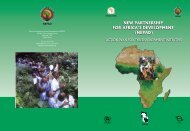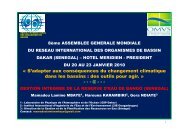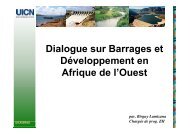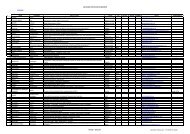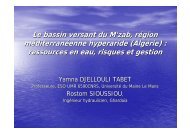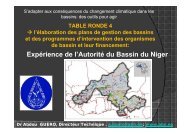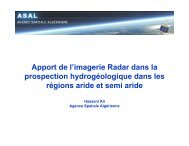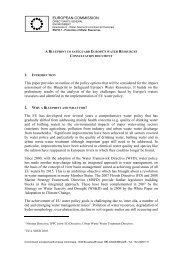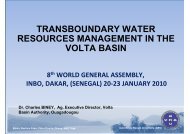The Past and the Future of Flood Management in the Eastern ... - INBO
The Past and the Future of Flood Management in the Eastern ... - INBO
The Past and the Future of Flood Management in the Eastern ... - INBO
Create successful ePaper yourself
Turn your PDF publications into a flip-book with our unique Google optimized e-Paper software.
Geography <strong>of</strong> <strong>the</strong> <strong>Eastern</strong> Nile Region:<br />
<strong>The</strong> <strong>Eastern</strong> Nile Bas<strong>in</strong> lies between latitudes 7º N <strong>and</strong> 31º N. <strong>The</strong> highl<strong>and</strong>s <strong>of</strong> Ethiopia<br />
are folded <strong>and</strong> fractured crystall<strong>in</strong>e rocks capped by sedimentary limestone <strong>and</strong><br />
s<strong>and</strong>stone, <strong>and</strong> by thick layers <strong>of</strong> volcanic lava. Elevations <strong>in</strong> <strong>the</strong> Ethiopian part <strong>of</strong> <strong>the</strong><br />
river bas<strong>in</strong> exceed 4 000 m <strong>in</strong> places <strong>and</strong> <strong>the</strong>re are large areas exceed<strong>in</strong>g 2 000 m. Most<br />
<strong>of</strong> <strong>the</strong> population lives on <strong>the</strong> elevated cooler plateaus above <strong>the</strong> steep river valleys where<br />
<strong>the</strong> soils are more fertile. Soil erosion is a major problem, accelerated by deforestation,<br />
overgraz<strong>in</strong>g <strong>and</strong> poor l<strong>and</strong> management. A key geographical feature <strong>in</strong> Ethiopia is Lake<br />
Tana, created by past volcanic activity, at a mean elevation <strong>of</strong> 1786.8 m ASL. Although<br />
shallow, <strong>the</strong> lake provides a degree <strong>of</strong> natural regulation <strong>of</strong> floods <strong>and</strong> captures sediment;<br />
however it regulates only a small fraction <strong>of</strong> <strong>the</strong> river bas<strong>in</strong> <strong>in</strong> Ethiopia. <strong>The</strong> outlet <strong>of</strong> <strong>the</strong><br />
Abbay River (or Blue Nile) from Lake Tana is located at <strong>the</strong> city <strong>of</strong> Bahir Dar, <strong>and</strong><br />
approximately 32 km downstream <strong>the</strong> river plunges over <strong>the</strong> Blue Nile Falls (Tiss Issat).<br />
After enter<strong>in</strong>g <strong>the</strong> Sudan, <strong>the</strong> rivers flow<strong>in</strong>g from Ethiopia traverse much flatter terra<strong>in</strong> at<br />
relatively low elevations, <strong>and</strong> longitud<strong>in</strong>al river bed slopes reduce dramatically.<br />
<strong>The</strong> average slope <strong>of</strong> <strong>the</strong> Abbay River between Lake Tana <strong>and</strong> <strong>the</strong> border is 1.6 m/km,<br />
but over <strong>the</strong> 735 km from <strong>the</strong> border to Khartoum <strong>the</strong> average slope <strong>of</strong> <strong>the</strong> Blue Nile is<br />
only 0.15 m/km. <strong>The</strong> catchment area <strong>of</strong> <strong>the</strong> Blue Nile to Khartoum is 324 530 km2. <strong>The</strong><br />
Blue Nile jo<strong>in</strong>s <strong>the</strong> White Nile at Khartoum, <strong>the</strong> capital <strong>of</strong> <strong>the</strong> Sudan. <strong>The</strong> White Nile<br />
flows north from <strong>the</strong> Equatorial Lakes region to <strong>the</strong> south, but despite its very large<br />
catchment area, seasonal floods from this region are very effectively mitigated, first by<br />
<strong>the</strong> Equatorial Lakes <strong>in</strong>clud<strong>in</strong>g Lake Victoria <strong>and</strong> o<strong>the</strong>r very large lakes, <strong>and</strong> second by<br />
<strong>the</strong> extensive marshes <strong>of</strong> <strong>the</strong> great Sudd <strong>in</strong> sou<strong>the</strong>rn Sudan. Downstream <strong>of</strong> Khartoum,<br />
<strong>the</strong> jo<strong>in</strong>t waters <strong>of</strong> <strong>the</strong> Blue Nile <strong>and</strong> White Nile form <strong>the</strong> Nile, or Ma<strong>in</strong> Nile, which flows<br />
1 350 km through extensive pla<strong>in</strong>s that are progressively more arid towards nor<strong>the</strong>rn<br />
Sudan to reach <strong>the</strong> Egyptian border. In Upper Egypt, <strong>the</strong> High Aswan Dam (HAD)<br />
creates by far <strong>the</strong> largest man-made reservoir <strong>in</strong> <strong>the</strong> entire Nile river bas<strong>in</strong> <strong>and</strong> regulates<br />
this vital source <strong>of</strong> water for multiple benefits downstream.<br />
Climate <strong>of</strong> <strong>the</strong> <strong>Eastern</strong> Nile Region:<br />
<strong>The</strong> elevated plateaus <strong>in</strong> Ethiopia experience cool to mild temperatures year round,<br />
whereas <strong>in</strong> central <strong>and</strong> nor<strong>the</strong>rn Sudan <strong>the</strong> climate is hot year-round <strong>and</strong> very hot <strong>in</strong> <strong>the</strong><br />
late spr<strong>in</strong>g <strong>and</strong> early summer (May to July). <strong>The</strong> far nor<strong>the</strong>rn part <strong>of</strong> <strong>the</strong> <strong>Eastern</strong> Nile<br />
river bas<strong>in</strong> <strong>in</strong> Lower Egypt experiences a Mediterranean climate, with mild w<strong>in</strong>ters <strong>and</strong><br />
hot summers. Ra<strong>in</strong>fall <strong>in</strong> Egypt is very low throughout <strong>the</strong> year with a low peak <strong>in</strong> w<strong>in</strong>ter<br />
months (December to February). Most ra<strong>in</strong>falls along <strong>the</strong> cost with 200 mm average <strong>in</strong><br />
<strong>the</strong> wettest area near Alex<strong>and</strong>ria. Some areas don’t receive any ra<strong>in</strong>s for many years <strong>and</strong><br />
<strong>the</strong>n experience sudden downpours that result <strong>in</strong> flash floods. Figures 2,3 <strong>and</strong> 4<br />
demonstrate <strong>the</strong> ra<strong>in</strong>fall distribution <strong>in</strong> Ethiopia, Egypt <strong>and</strong> Sudan respectively.<br />
4



